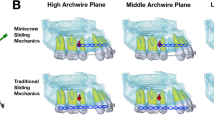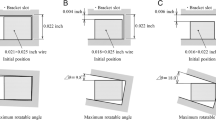Abstract
This study aims to analyse the stress distributions and initial displacements of teeth during the space closing stage through a three-dimensional finite element method. Computed tomography images of a patient were used to reconstruct the detailed teeth and alveolar bone, and brackets with stainless steel archwire were modelled according to the orthodontic prescriptions. The second premolars and first molars were chosen as the anchorages in the model 6-force, with buccal tubes attached to the second molars in the model 6-force-7, and the second molars as additional anchorages in the model 7-force. The results indicated that a movement of lingual lateral inclination occurred on the incisors during the retraction, and the frictional force between the teeth and the archwire significantly reduced the stress on the teeth and periodontal structures.

Malocclusion is one of the most common issue in dentistry with high prevalence and orthodontic treatment need. The extraction of first premolar teeth was normally needed at the beginning of the treatment. And the straight wire appliance together with the sliding mechanics was used for space closure at the end of the treatment. However, side effects like root resorption also found after the surgery. Biomechanically, the stress distributions and initial displacements of teeth during space closing stage might be a crucial factor contributed to those undesirable side effects. And different selections of anchorages might alter the biomechanical environment during the treatment. Thus, the purpose of the current study was to analyse the stress distributions and initial displacements, with the different anchorage selections, of teeth during space closing stage through 3D finite element method.





Similar content being viewed by others
References
Dimberg L et al (2015) Prevalence and change of malocclusions from primary to early permanent dentition: a longitudinal study. 85(5):728–734
Bourauel C et al (1999) Simulation of orthodontic tooth movements. 60(2):136–151
Bourauel C, Vollmer D, Jager A (2000) Application of bone remodeling theories in the simulation of orthodontic tooth movements. 61(4):266–279
Burstone CJ, Pryputniewicz RJ (1980) Holographic determination of centers of rotation produced by orthodontic forces. 77(4):396–409
Cobo J et al (1996) Dentoalveolar stress from bodity tooth movement at different levels of bone loss. 110(3):256–262
Kojima Y, Fukui H (2006) A numerical simulation of tooth movement by wire bending. 130(4):452–459
Kojima Y, Fukui H (2010) Numeric simulations of en-masse space closure with sliding mechanics. 138(6):702. e1–702. e6
Kojima Y, Fukui H (2005) Numerical simulation of canine retraction by sliding mechanics. 127(5):542–551
Qian Y et al (2008) Numerical simulation of tooth movement in a therapy period. 23:S48–S52
Schneider J et al (2002) Numerical experiments on long-time orthodontic tooth movement. 121(3):257–265
Tanne K et al (1988) Moment to force ratios and the center of rotation. 94(5):426–431
Tanne K et al (1987) Three-dimensional finite element analysis for stress in the periodontal tissue by orthodontic forces. 92(6):499–505
Vollmer D et al (1999) Determination of the centre of resistance in an upper human canine and idealized tooth model. 21(6):633–648
McCormack SW et al (2017) Inclusion of periodontal ligament fibres in mandibular finite element models leads to an increase in alveolar bone strains. PLoS One 12(11):e0188707
Jeon PD et al (1999) Analysis of stress in the periodontium of the maxillary first molar with a three-dimensional finite element model. 115(3):267–274
Meling TR et al (1998) On bracket slot height: a methodologic study. 113(4):387–393
Rinchuse DJ et al (2007) Orthodontic appliance design. 131(1):76–82
Matasa CG (1996) Bracket angulation as a function of its length in the canine distal movement. 110(2):178–184
Kusy RP, Whitley JQ, Prewitt MJ (1991) Comparison of the frictional coefficients for selected archwire-bracket slot combinations in the dry and wet states. 61(4):293–302
Tominaga JY et al (2009) Optimal loading conditions for controlled movement of anterior teeth in sliding mechanics: A 3D finite element study. 79(6):1102–1107
Kim T et al (2010) Optimum conditions for parallel translation of maxillary anterior teeth under retraction force determined with the finite element method. 137(5):639–647
Sung S-J et al (2010) Effective en-masse retraction design with orthodontic mini-implant anchorage: a finite element analysis. 137(5):648–657
Zhang Y et al (2009) Three dimensional finite element analysis of maxillary anterior teeth retraction with micro-implant anchorage and sliding mechanics. 27(5):557–560
Liu Z, Qian Y, Fan Y (2010) Effects of Different Material Properties of Enamel and Pulp on the Stress Distributions of the Alveolar Tissues. 42(06):187–191
Chopra S et al (2017) Comparative evaluation of anchorage reinforcement between orthodontic implants and conventional anchorage in orthodontic management of bimaxillary dentoalveolar protrusion. 73(2):159–166
Talic NF (2011) Adverse effects of orthodontic treatment: a clinical perspective. Saudi Dental J 23(2):55–59
Fernández JR et al (2003) A three-dimensional numerical simulation of mandible fracture reduction with screwed miniplates. 36(3):329–337
Telli C, Gülkan P, Raab W (1999) Endodontics: Additional studies on the distribution of stresses during vertical compaction of gutta-percha in the root canal. 187(1):32
Cobo J et al (1993) Initial stress induced in periodontal tissue with diverse degrees of bone loss by an orthodontic force: tridimensional analysis by means of the finite element method. 104(5):448–454
Middleton J et al (1990) Three-dimensional analysis of orthodontic tooth movement. 12(4):319–327
Knox J et al (2001) An evaluation of the influence of orthodontic adhesive on the stresses generated in a bonded bracket finite element model. 119(1):43–53
Andreasen GF, Zwanziger D (1980) A clinical evaluation of the differential force concept as applied to the edgewise bracket. Am J Orthod 78(1):25–40
Park H-S, Kwon T-G (2004) Sliding mechanics with microscrew implant anchorage. Angle Orthod 74(5):703–710
Basha AG, Shantaraj R, Mogegowda SB (2010) Comparative study between conventional en-masse retraction (sliding mechanics) and en-masse retraction using orthodontic micro implant. Implant Dent 19(2):128–136
Hohmann A et al (2007) Periodontal ligament hydrostatic pressure with areas of root resorption after application of a continuous torque moment: a study using identical extracted maxillary human premolars. 77(4):653–659
Maués CPR, do Nascimento R, Vilella Ode V (2015) Severe root resorption resulting from orthodontic treatment: prevalence and risk factors. 20(1):52–58
Mirabella AD, Årtun J (1995) Risk factors for apical root resorption of maxillary anterior teeth in adult orthodontic patients. Am J Orthod Dentofac Orthop 108(1):48–55
Levander E, Bajka R, Malmgren O (1998) Early radiographic diagnosis of apical root resorption during orthodontic treatment: a study of maxillary incisors. Eur J Orthod 20(1):57–63
Killiany DM (1999) Root resorption caused by orthodontic treatment: An evidence-based review of literature. In: Seminars in orthodontics. Elsevier
Sameshima GT, Sinclair PM (2001) Predicting and preventing root resorption: part II. Treatment factors. Am J Orthod Dentofac Orthop 119(5):511–515
Scheurer PA, Firestone AR, Bürgin WB (1996) Perception of pain as a result of orthodontic treatment with fixed appliances. Eur J Orthod 18(1):349–357
Parkhouse RC (1998) Rectangular wire and third-order torque: a new perspective. 113(4):421–430
Funding
This work was supported by the National Natural Science Foundation of China [grant number 31670963 and 11421202].
Author information
Authors and Affiliations
Corresponding author
Ethics declarations
Conflict of interest
The authors declare that they have no conflict of interest.
Additional information
Publisher’s note
Springer Nature remains neutral with regard to jurisdictional claims in published maps and institutional affiliations.
Rights and permissions
About this article
Cite this article
Liu, Z., Sun, T. & Fan, Y. Biomechanical influence of anchorages on orthodontic space closing mechanics by sliding method. Med Biol Eng Comput 58, 1091–1097 (2020). https://doi.org/10.1007/s11517-020-02149-1
Received:
Accepted:
Published:
Issue Date:
DOI: https://doi.org/10.1007/s11517-020-02149-1




